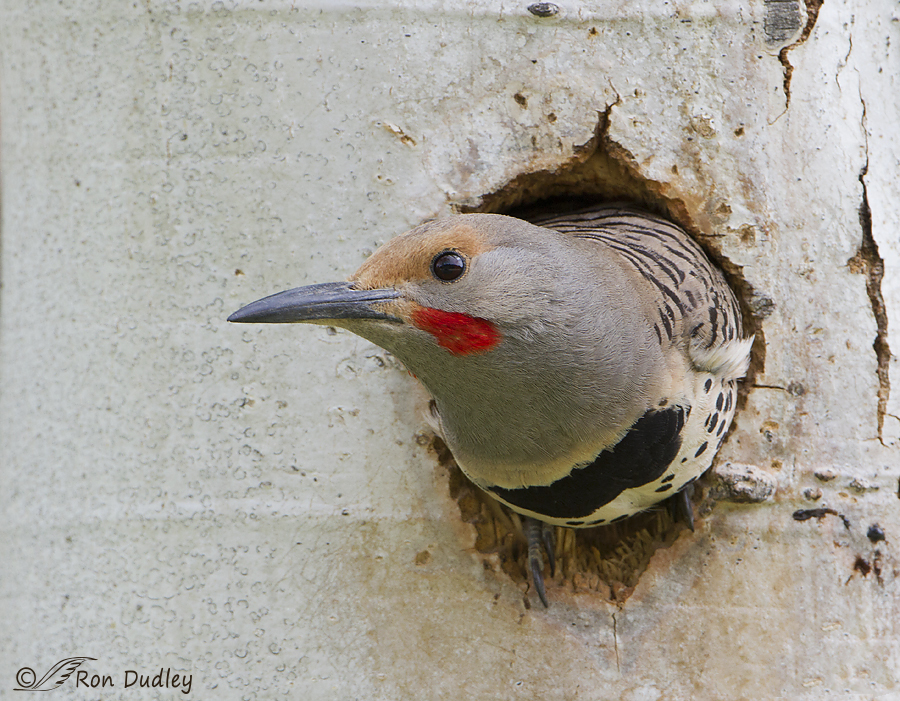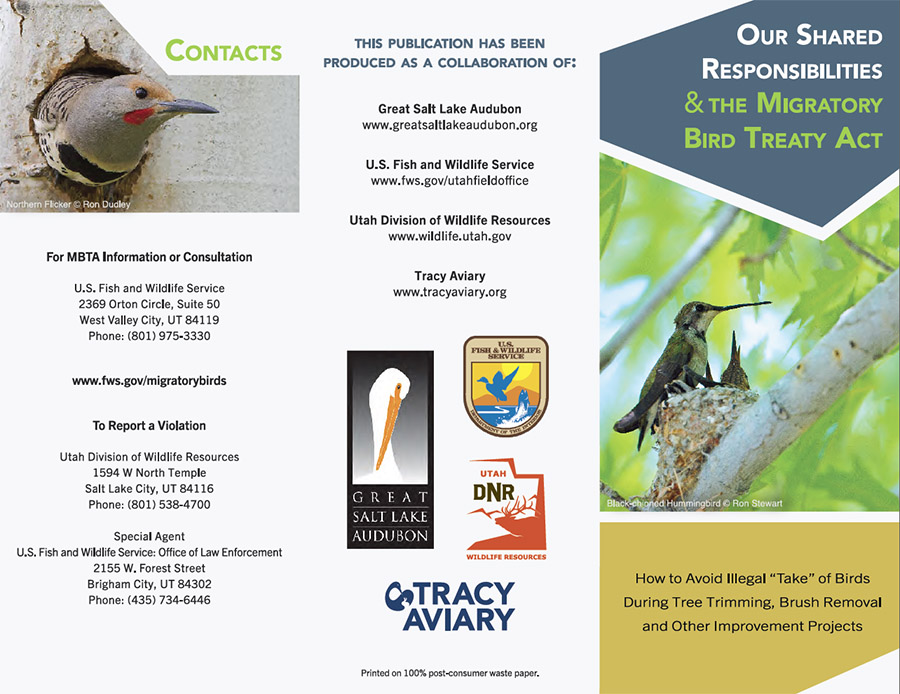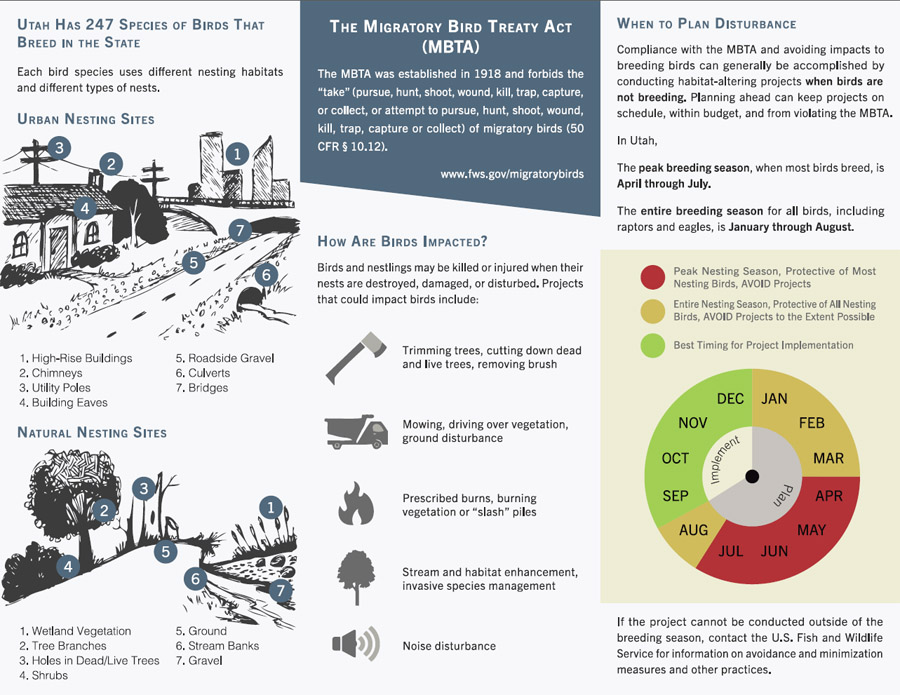I’m delighted to see government agencies and conservation groups working together to protect vulnerable nesting birds.
 1/200, f/10, ISO 640, Canon 7D, Canon EF500mm f/4L IS USM +1.4 tc, not baited, set up or called in
1/200, f/10, ISO 640, Canon 7D, Canon EF500mm f/4L IS USM +1.4 tc, not baited, set up or called in
I became aware of this developing effort last November when Janice Gardner of Great Salt Lake Audubon (GSLA) put out a request through UBird for some “attractive graphics” from bird photographers to illustrate an informational package for distribution to city managers, county officials, state leaders, park managers and others informing them how they can protect migratory birds, especially during breeding season. I sent her several images that I thought might be appropriate and helpful and eventually this Northern Flicker image was chosen for one of the documents.
The photo was taken near Montana’s Wade Lake as the flicker emerged from its nest cavity (which at first I didn’t even realize was occupied). It’s the same image as in the document below, though it has been “flipped” and cropped for compositional purposes.


Each year migratory birds that are protected under the Migratory Bird Treaty Act (50 CFR § 10.12) are needlessly killed or harmed during the course of planned construction, tree trimming, mowing vegetation, and other habitat-altering projects. Unfortunately the surge in these types of human activities in spring and summer coincides with the nesting seasons of most bird species and the results can be catastrophic for them.
Nearly all birds in the United States are protected by the Migratory Bird Treaty Act of 1918, with the exception some upland game birds and non-native species such as European Starling and House Sparrow. Under the Migratory Bird Treaty Act, it is unlawful for anyone to “take” a migratory bird or their parts, nests, or eggs unless permitted to do so. The term “take” is defined as to “pursue, hunt, shoot, wound, kill, trap, capture, or collect.”
These activities that negatively impact birds are often unintentional and many members of the public and private community do not understand their responsibilities under the Migratory Bird Treaty Act. With the goal of spreading information on the protection of birds, Great Salt Lake Audubon teamed with the U.S. Fish and Wildlife Service, Utah Division of Wildlife Resources, and Tracy Aviary to distribute information on the Migratory Bird Treaty Act. They received valuable input from Salt Lake City and Salt Lake County. Together they have created and distributed an informational brochure and “best practices” document to regional public managers and other interested parties.
Compliance with the Migratory Bird Treaty Act and avoiding impacts to breeding birds can generally be accomplished by conducting habitat-altering projects when birds are not breeding. In Utah, the peak breeding season when most birds breed, is April through July. The entire breeding season for all birds, including raptors and eagles, is January through August. If projects can be timed to avoid the breeding season, impacts are greatly minimized or avoided.
These documents have now been distributed in hardcopy and online (GSLA website, USFWS website, UBird, etc). I’ve included links to them below where the PDF’s can be downloaded and distributed by interested parties.
The “Brochure” is the same document as seen above while the USFWS “Best Practices” document is a much more detailed overview describing the responsibilities we all have to avoid negative impacts on migratory bird populations and appropriate methods to avoid those impacts. I know that many of my readers are involved in bird conservation efforts and I thought that access to the documents for informational reasons or possible redistribution might be helpful to your efforts.
After all, it is not only the ethical responsibility of public and private entities to protect migratory birds, it is the law!
Ron


Ron, thank you for all you do to promote conservation in general and for birds specifically. Through your “educational art” we are all continuing to learn and remain motivated.
Congratulations on another superb photograph being used for such a positive message.
Yay!
Congrats! What a wonderful compliment to your photography. How gratifying to be able to contribute! Sensational image by the way.
Charlotte
Thanks on all counts, Charlotte.
Nice to be able to find something good and positive to pass on and share!!!
Agreed, Patty. Thanks.
Brilliant.
If you listen carefully you will hear me clapping and cheering from here.
We need something similar too.e
I listened and I heard, EC. Thank you.
It’s heartening, even thrilling, to learn of this collaborative educational effort—-I truly think that the majority of human-caused harm to wildlife and habitat isn’t malicious–it’s just ignorance……
“I truly think that the majority of human-caused harm to wildlife and habitat isn’t malicious–it’s just ignorance……”
You may be right, Kris. I certainly hope so, though I do think much of the “war on predators” in particular is malicious.
Is there any way you could send me a scanned copy of the brochure for our facebook page and to send to parks and other city folks here? Or a contact at one of the agencies who put it together? It’s absolutely perfect and something we badly need. Makes we crazy when folks call because they were trimming hedges in the spring and disturbed a nest! And I think logging should be limited to that Sep-Dec period, too. Thanks, Ron – maybe I should email you directly.
Louise, I think that can be done. I’ll respond to your email.
This is AWESOME, Ron!! I’ve shared it with our B3Branch Buddies FaceBook group(B3 was last season’s juvenile eagle who fledged from the Berry College eagle nest. We have close to 700 members from throughout the US and some foreign countries. I’m sure they will take & use the info no matter where they live & will pass it on to others. This is where social media can be used for good!
That’s wonderful, Jo Ann. Thank you for helping to get the word out.
Congrats Ron! Great brochure and great image of the Northern Flicker!
Thanks, Nancy, but really the congrats are most deserved by the folks who put this effort together. Something like this takes a lot of planning, foresight and teamwork.
I’ve been aware, even living in an area where outdoor projects can basically be done all year long, that there is an upsurge in activity in spring and summer. But it has never occurred to me that such things impact nesting birds. Thanks for opening my eyes.
Susan, Locally, as in most places, it’s been a very large problem. For example, community parks often undertake massive tree trimming and clearing projects exactly when those trees have nesting birds in them. Better planning and timing can mitigate the issue to a very large degree.
Being a European citizen it is always interesting to know how you deal with this problem.
Thank you very much for sharing it.
And by the way that photo is wonderful.
The problem is universal, isn’t it, Jorge? Thank you.
Hi Ron,
Thanks so much for posting this. I will share this with others in my state in the hopes that we might be able to create something similar! Very important news!
Thanks again,
Gail
“I will share this with others in my state in the hopes that we might be able to create something similar! ”
Perfect! Thanks very much, Gail.
Ron, thanks for reminding me that we all have responsibilities to the wild birds that give ao much pleasure. What would the world be without flickers, juncos and even starlings? And of course the magnificent birds of prey you show us.m
Yep, it’s easy to forget how much impact we have on birds, Diana – especially when they’re nesting. Thank you.